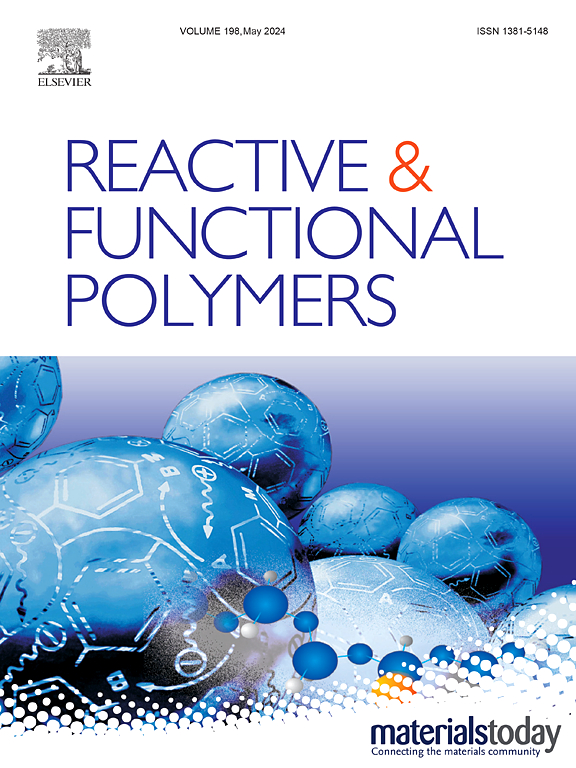由生物基硬化剂和聚乙二醇制备的双动态环氧玻璃体:合成、理化性质、超分子效应、绿色化学指标和DFT研究
IF 5.1
3区 工程技术
Q1 CHEMISTRY, APPLIED
引用次数: 0
摘要
在这项研究中,我们提出了一种具有双可逆键的新型环氧玻璃体的发展。通过在香草素衍生的硬化剂结构中整合亚胺键,并通过添加聚乙二醇(PEG)引入超分子相互作用,我们设计了一种具有增强可回收性、可再加工性和可治愈性的材料。PEG的存在诱导了超分子相互作用,特别是氢键,从而提高了机械性能(例如,断裂韧性从0.844提高到1.019 MPa.m0.5)、耐热性、改善了自愈性、更高的存储模量和更快的应力松弛。我们的实验发现,通过密度泛函理论(DFT)计算初步验证,表明相互作用能增加,证实了这些双可逆键的协同效应。这种双键结合方法不仅保持了材料的结构完整性和机械性能,而且显著提高了材料的再加工和自修复能力。易于使用的绿色化学指标和简化的生命周期评估(LCA),即EcoScale和green MOTION量表,也被认为可以深入了解用于制备硬化剂和玻璃化剂的过程的效率和绿色度。这项工作为未来的材料设计树立了先例,展示了结合多种动态粘合机制以实现卓越材料性能和可持续性的潜力。本文章由计算机程序翻译,如有差异,请以英文原文为准。

Dual dynamic epoxy vitrimer feasibly made from a bio-based hardener and PEG: Synthesis, physico-chemical properties, supramolecular effects, green chemistry metrics, and DFT study
In this study, we present the development of a novel epoxy vitrimer with dual reversible linkages. By integrating imine bonds within a vanillin-derived hardener structure and introducing supramolecular interactions through the addition of poly(ethylene glycol) (PEG), we have feasibly engineered a material exhibiting enhanced recyclability, reprocessability and healability. The presence of PEG induces supramolecular interactions particularly H-bonding, resulting in increased mechanical properties (e.g., fracture toughness from 0.844 to 1.019 MPa.m0.5), thermal resistance, improved self-healing, higher storage modulus and faster stress relaxation. Our experimental findings, preliminarily verified by density functional theory (DFT) calculations, demonstrated an increase in interaction energy, confirming the synergistic effect of these dual reversible bonds. This dual bonding approach not only maintains the material's structural integrity and mechanical properties but also significantly improves its reprocessing and self-healing capabilities. Easy-to-use green chemistry metrics and simplified life-cycle assessment (LCA), i.e., EcoScale and GREEN MOTION scales, were also considered to provide an insight into the efficiency and greenness of the processes used to prepare the hardener and vitrimers. This work sets a precedent for future materials design, showcasing the potential of combining multiple dynamic bonding mechanisms to achieve superior material performance and sustainability.
求助全文
通过发布文献求助,成功后即可免费获取论文全文。
去求助
来源期刊

Reactive & Functional Polymers
工程技术-高分子科学
CiteScore
8.90
自引率
5.90%
发文量
259
审稿时长
27 days
期刊介绍:
Reactive & Functional Polymers provides a forum to disseminate original ideas, concepts and developments in the science and technology of polymers with functional groups, which impart specific chemical reactivity or physical, chemical, structural, biological, and pharmacological functionality. The scope covers organic polymers, acting for instance as reagents, catalysts, templates, ion-exchangers, selective sorbents, chelating or antimicrobial agents, drug carriers, sensors, membranes, and hydrogels. This also includes reactive cross-linkable prepolymers and high-performance thermosetting polymers, natural or degradable polymers, conducting polymers, and porous polymers.
Original research articles must contain thorough molecular and material characterization data on synthesis of the above polymers in combination with their applications. Applications include but are not limited to catalysis, water or effluent treatment, separations and recovery, electronics and information storage, energy conversion, encapsulation, or adhesion.
 求助内容:
求助内容: 应助结果提醒方式:
应助结果提醒方式:


